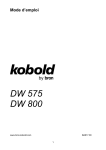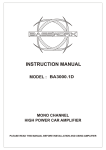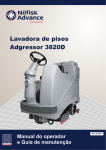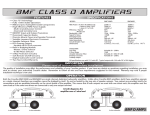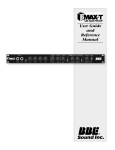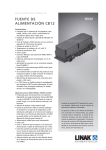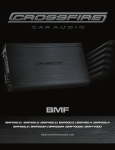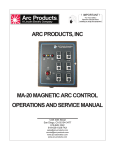Download Bassworx BA1200.1D Instruction manual
Transcript
INSTRUCTION MANUAL MODEL : BA150.1 BA75.2 BA150.2 BA75.4 BA500.1D BA800.1D BA1200.1D STEREO/MONO BRIDGEABLE HIGH POWER CAR AMPLIFIER PLEASE READ THIS MANUAL BEFORE INSTALLATION AND USING AMPLIFIER Congratulations on your Purchase Your new high fidelity bridgeable/stereo amplifier is designed to deliver maximum enjoyment and one year of trouble free service. Please take a few moments to read this manual thoroughly. It will explain the features and operation of your unit and help insure trouble free installation. Features CLASS ''AB'' CLASS ''D'' Class ''AB'' Technology MOSFET PWM Power Supply. ¡ Bridgeable & TRI-Mode Operation. ¡ Continuously Variable 12dB/Octave High Pass & 12dB/Octave Low Pass Crossover. ¡ Subwoofer Variable Crossover for Deep Bass Control. ¡ Enhanced Variable Bass Boost +12dB @ 50Hz. ¡ Soft Start & Muting. ¡ Overload, Thermal, Short Circuit Protection. ¡ Power & Protection indicator. Fully 1 Ohm Stable Operation Military Spec Audiophile Grade Components ¡ High Efficiency PWM Power Supply - Multi-stranded Power Torroid - Two Torroidial Core - MOSFET Transistors ¡ Over Sized Capacitor Banks ¡ Discrete Mount Power & Speaker Terminals ¡ Varible Lowpass Electronic Crossover ¡ Varible Subsonic Filter ¡ 3way Protection Circuitry ¡ Soft Remote On/off Circuitry ¡ Digital Subwoofer Level Control ¡ ¡ ¡ Precautions: Read First! - If after reading the direction you feel uncomfortable about installing the amplifier in your car, or not equipped or competent to do so, you should have the amplifier installed by an authorized installer. It's your car! - Negative battery terminal must be disconnected before any electrical connection are made. - Be sure choose a location that provides substantial ventilation for the amplifier. The most preferred locations would be in your car's trunk, under the front seats or on the back wall of a truck. - The location chosen should provide at least 2" of clearance above the amplifier for adequate ventilation. - If the amplifier is to be mounted vertically be sure that it is in a place where adequate air will flow along the length of its heatsink fins for cooling. - NEVER mount the amplifier up side down, this will cause the heat to rise back into the amplifier causing thermal shutdown or possible permanent damage. - NEVER mount the amplifier in a location that is subject to direct sunlight or exposed to moisture. 1 Precautions: Read First! - Be sure to mount the amplifier to a strong, solid surface which will not give way under the stress of a sudden stop or accident. - Make sure that the mounting screws will not penetrate the gas tank, brake and fuel lines, wiring or other critical parts of your car when installed. - NEVER operate the amplifier without the proper power and ground wire 10 gauge minimum. - NEVER operate the amplifier without proper fusing. Fuse holder must be located with in 0.5 meters from the battery. This fuse is to protect the car not the electronics. In case of a short, the fuse will blow instead of the wire burning up. Using other than the recommended fuse ratings at the battery and at the amplifier may cause damage to the amplifier and will void your warranty. - Do not run wiring underneath or outside the car since exposure to the elements may cause the insulation to deteriorate rapidly, resulting in short-circuits and/or intermittent operation. All cables should be run beneath carpets and inside trim pieces. - To help minimize interference, it is best to run the power cables along the opposite side from the audio cables. - Whenever wires pass through metal, rubber or plastic grommets must be used to prevent the mental from wearing through the installation and causing a short. - Whenever possible, use cable ties, mounting clamps and similar wiring aids. (available from an electrical supply or auto parts store) Adding stress relief loops to wiring is also advisable to prevent straining or breakage. - It is best to test the system before the amplifier is mounted and interior of car is reassembled. - If the temperature inside your car reaches extreme levels(such as sitting locked up for several hours in the hot sun or exposed to a very cold winter's day)the amplifier may go into protection mode and shut off. Leave the unit off until the ambient temperature returns to normal. - The amplifier operates with any vehicle using a 12 volt negative ground system. If you are not sure of the type of electrical system in your vehicle, consult your authorized dealer or qualified mechanic. - NEVER ground the speaker leads and NEVER allow the speaker leads to come in contact whit each other. Speaker wire should be 18 gauge or larger. - Remote turn on wire must be switched by the radio does not have a remote turn on or antenna output, connect to wire that has a positive 12 volts when the key is turned to the accessory. If the amplifier does not turn off the battery will die. - Do not listen to high volumes for extended periods of time or hearing damage may occur. CONTINOUS EXPOSURE TO SOUND PRESSURE LEVELS OVER 100dB MAY CAUSE PERMANENT HEARING LOSS. HIGH POWERED AUTOSOUND SYSTEM MAY PRODUCE SOUND PRESSURE LEVELS WELL OVER 130dB. USE COMMON SENSE AND PRACTICE SAFE SOUND. 2 Installation MOUNTING: 1. After reading precaution, decide where you are going to install the unit. Also, see Fig.1. 2. Once the location has been determined, place the amplifier in position. Using a felt tip pen or pencil mark the four holes to be drilled for mounting. NEVER use the amplifier as a template for drilling. It is very easy to damage the amplifier surface in manner. 3. Remove amplifier. Drill four 3.5 m/m. Diameter holes into mounting surface on steel panel. If you want mounting the MDF or wood panel, drill four 3.0m/m diameter holes into mounting surface. 4. If possible, test the system operating before final mounting of the amplifier. 5. Mount the amplifier using the supplied 4 self threading screws. Installation Diagram SELF TAP SCREWS Fig1. 3 Input Connections This amplifier will accept low level inputs. Low level is the same as line level or preempt level. Low level signal is carried through RCA cables. It is preferred to use low level inputs to the amplifier if the head unit is equipped with the low level outputs. Low level/line input-connect RCA cables from head unit, or other signal processor, to the line level input on the amplifier. See Fig.2 system wiring diagrams. Power Connections It is important to have good quality power and ground connections. Remember, to complete an electrical circuit, the ground connection is just as important as the positive power connection. Before any power connections are made, disconnect the ground cable at the battery. When the power supply lead. Memory backup lead or ground lead are extended, use a 5mm 2 (AWG5) or larger automotive grade cable which will withstand friction and heat to safe guard against fires occurring as a result of short-circuiting. Ground-Connect the proper gauge ground wire to the amplifier "GND" terminal. Locate the position on the chassis of the car to which the amplifier is to be ground. The surface must be free from any paint or dir. This can be accomplished with a small grinding bit or wire wheel. NOTE: Do not ground amplifier to the "frame" of the car, the frame on most cars and trucks is not grounded to the chassis (body). Solder or clamp ring terminal to ground wire. Pretrial the prepped chassis metal to bolt the ground ring terminal with nut, bolt and lock washers. Insulate mental and connector with paint or silicon to prevent rust and oxidation. Silicon also works great to prevent nuts and bolts from working loose in a harsh environment of an automobile. Upon completion of ground connection, grab wire or connector and confirm that it is a solid connection. To prevent engine noise, it is recommended to ground the head unit and other audio electronics in the same location. Remote Turn-on-Connect smaller light gauge wire to "REMOTE" terminal of amplifier and to remote/ antenna turn-on output or "remote amplifier" of head unit. If head unit is not equipped with a remote/ antenna output, locate a wire that is controlled by the accessory position of the key. It is important to have the amplifier turn off with the radio or key. If the amplifier remains on, the result will most likely be a dead battery. Positive-Connect the proper size wire to the amplifier "B+" terminal of amplifier. Run wire to wards the fuse holder that is no greater then 0.5 meters from the battery. Remember, the fuse is to protect the safety of the car in the case of a short. Connect fuse holder to battery, however, do not install fuse at this time. 4 1 CHANNEL SYSTEM WIRING DIAGRAM LOW INPUT LINE OUTPUT POWER PROTECT SUBSONIC FILTER L L 6V 0.24V 15Hz 45Hz R LEVEL ON OFF 0 180 0dB 12dB PHASE BASS EQ 50Hz 250Hz LOW PASS REMOCON +12V REM GND R AUTO-ANTENNA LEAD CH1 CH2 CAR STEREO HEAD UNIT EXTEND AMPLIFIER Fig.2 5 2 CHANNEL SYSTEM WIRING DIAGRAM +12V REM GND AUTO-ANTENNA LEAD CH1 CH2 CAR STEREO HEAD UNIT EXTEND AMPLIFIER Fig.2 6 4 CHANNEL SYSTEM WIRING DIAGRAM +12V REM GND AUTO-ANTENNA LEAD CH1 CH3 CH2 CH4 CAR STEREO HEAD UNIT Extend Amplifier Fig.2 7 MONO CHANNEL SYSTEM WIRING DIAGRAM LINE INPUT SUBSONIC FILTER L.P.F GAIN PHASE REMOCON MASTER SLAVER SLAVE L 6V 0.24V 50Hz 250Hz 15Hz 50Hz OFF ON 0° 180° R +12V REM GND AUTO-ANTENNA LEAD CH1 CH2 CAR STEREO HEAD UNIT EXTEND AMPLIFIER Fig.2 8 Speaker Connections This amplifier can operate in either one, two or three channel mode. The minimum impedance for single channel (bridged/mono) operation is 4-8 ohms. There channel tri-power is referred to stereo and mono at the same time. Minimum impedance remain the same for three channel (satellite/ subwoofer) systems as long as proper passive crossovers are used. Connect right and left speaker wire to corresponding speaker output terminals of the amplifier. Be sure to have the positive wire from the speaker to the positive speaker terminal of the amplifier and the negative wire from the speaker must connect with the negative speaker terminal of the amplifier. Reversing any of these connections will result in the speaker cones moving out of phase which causes bass cancellation. See Fig.3 Speaker Output Connections. 1 CHANNEL SPEAKER WIRING DIAGRAM 1 SPEAKER BRIDGED FUSE SPEAKER +12VDC REM GND POWER 1 CH 2-8 Ohms Fig.3 9 2 CHANNEL SPEAKER WIRING DIAGRAM 1 SPEAKER BRIDGED 1 CH 4-8 Ohms 2 SPEAKER STEREO 2-4 Ohms 2 CH 1 CH 3 SPEAKER TRI MODE 4-8 Ohms 2 CH 1 CH 4-8 Ohms WOOFER 2CH+1CH Fig.3 10 4 CHANNEL SPEAKER WIRING DIAGRAM 2 SPEAKER BRIDGED 4-8 Ohms 2 CH 1 CH 2 SPEAKER + 1 SUBWOOFER 3 CH 2-4 Ohms 2 CH 2-4 Ohms 1 CH 4-8 Ohms SUB WOOFER 4 SPEAKER STEREO 2-4 Ohms 2-4 Ohms 2 CH 4 CH 3 CH 1 CH 6 SPEAKER HEX MODE 2 CH 4-8 Ohms 6 CH 4-8 Ohms 4 CH 4-8 Ohms 3 CH 4-8 Ohms 1 CH 4-8 Ohms 5 CH 4-8 Ohms 11 Fig.3 MONO CHANNEL SPEAKER WIRING DIAGRAM 4OHM SUBWOOFER 4OHM SUBWOOFER 4OHM SUBWOOFER 4OHM SUBWOOFER In both diagrams, the amplifier sees a 2 ohm load. BRIDGED MONO Fig.3 12 Adjustments 1. Set to the "H.P.F" position when the amplifier is used to drive a tweeter/midrange system. The frequencies below the crossover point will be attenuated at 12dB/octave. Permits adjustment of the crossover frequency ,by rotating the knob to select any frequency between 60Hz to 1.2KHz as the crossover point. 2. Set to the "L.P.F" position when the amplifier is used to drive a subwoofer. The frequencies above the crossover point will be attenuated at 12dB /octave. Permits adjustment of the crossover frequency, by rotating the knob to select any frequency between 50Hz to 250 Hz as the crossover point. 3. Set to the "OFF" position when the amplifier will be used for driving full-range speakers. The full frequency bandwidth will be output to the speakers without high or low frequency attenuation. 4. Level adjustment-The sensitivity adjustment is to allow the amplifier to work with many different brands of head units. It allows input signal to vary between 350 millivolts to 5 volt from the head unit or other signal processor. Start by setting the sensitivity adjustment to the "MIN" (3 volts). Using a cassette or compact disc that you are familiar with ,turn on head unit to the 3/4 volume setting. Slowly turn up sensitivity adjustment towards the "MAX" (200 millivolts) using a flat head screw driver. Stop turning on the onset of distortion and turn back just a slight. The 3/4 volume setting is now the "maximum" volume for the head unit. The goal is to keep the level control to the lowest setting yet still have enough signal to drive the amplifier. This is done to prevent over driving the amplifier and to keep system noise to a minimum. It is important not over drive speakers (at point of distortion) this will cause permanent damage to the speakers. Also, if the amplifier itself is over driven, it could be damaged. FRONT PANEL LOW INPUT 1 CHANNEL LINE OUTPUT POWER PROTECT SUBSONIC FILTER L L 6V 0.24V 15Hz 45Hz ON OFF LEVEL R 0 180 0dB 12dB 50Hz 250Hz PHASE BASS EQ LOW PASS REMOCON R 2 CHANNEL LOW INPUT POWER PROTECT SUBSONIC FILTER L.P.F REMOCON LINE OUTPUT H.P.F L L 6V 0.24V 15Hz 45Hz ON OFF 0 180 0dB 12dB 50Hz 250Hz LOW PASS PHASE BASS EQ LEVEL R L.P.F H.P.F 60Hz 1.2kHz FULL HIGH PASS R 4 CHANNEL LINE INPUT MONO CHANNEL SUBSONIC FILTER L.P.F GAIN PHASE L 6V 0.24V 50Hz R 13 250Hz 15Hz 50Hz OFF ON 0° 180° REMOCON MASTER SLAVER SLAVE Trouble Shooting The System We have put together this trouble-shooting guide if you experience problems after installing the amplifier. Please keep in mind that the majority of problems incurred are caused by improper installation and not the equipment itself. In addition, there are many components in the system that could cause various signal problems such as inducted electrical noise and engine noise. Before you can properly address the problem, you must first find the component that is causing the problem. This will take patience and a process of elimination. LOOK FOR.... SOLUTION No Output Blown fuse Bad RCA Cable(s) +12V at power terminal +12V at remote terminal Grounding point clean and tight Head Unit's fader not in center position Replace Replace Check connection Check connection Check for ground w/meter Set to center position Low Output Check level adjustments Bad RCA cable(s) Improper level matching Re-adjust Replace Re-adjust Engine Noise Grounding points are clean and tight Ground all components at same point Try different grounding point Bad RCA cable(s) Use High Quality shielded RCA cables Low Vehicle charging system and/or battery Check for ground w/meter Ground at same point Change for better ground Replace Rejects inducted noise Fix and/or replace Red Protection L.E.D. Illuminated Speaker short Check speakers connection for short circuit Make sure speaker wires do not touch chassis ground Check speaker impedance (Min 2 ohm Stereo, 4 Mono) Check mounting location for Adequate air Circulation Speaker impedance too low Speaker grounding out Impedance too low Overheating 14 Specification AMPLIFIER BA150.1 BA75.2 BA150.2 BA75.4 BA500.1D BA800.1D BA1200.1D 4 OHMS @ 0.05% THD (20Hz - 30kHz) 150W x 1 75W x 2 150W x 2 75W x 4 210W x 1 350W x 1 450W x 1 2 OHMS @ 0.05% THD 300W x 1 150W x 2 300W x 2 150W x 4 380W x 1 550W x 1 800W x 1 4 OHMS Bridged 1% THD N/A 300W x 1 600W x 1 300W x 2 N/A N/A N/A 1 OHMS 1% THD N/A N/A N/A N/A 500W x 1 800W x 1 1200W x 1 R.M.S OUTPUT POWER 150 Watts 150 Watts 300 Watts 300 Watts 500 Watts 850 Watts 1200 Watts LOW PASS FILTER (VARIABLE) (VARIABLE) (VARIABLE) (VARIABLE) (VARIABLE) (VARIABLE) (VARIABLE) 50Hz-250Hz 50Hz-250Hz 50Hz-250Hz 50Hz-250Hz 50Hz-250Hz 50Hz-250Hz 50Hz-250Hz HIGH PASS FILTER N/A (VARIABLE) (VARIABLE) (VARIABLE) N/A 60Hz-1.2kHz 60Hz-1.2kHz 60Hz-1.2kHz N/A N/A PHASE CONTROL 0¢~180¢ N/A 0¢~180¢ 0¢~180¢ 0¢~180¢ 0¢~180¢ 0¢~180¢ VARIBLE SUBSONIC FILTER 15Hz-45Hz N/A 15Hz-45Hz N/A 15Hz-50Hz 15Hz-50Hz 15Hz-50Hz FREQUENCY RESPONSE (-1dB) 10Hz-250kHz 10Hz-40kHz 10Hz-40kHz 10Hz-40kHz 10Hz-250Hz 10Hz-250Hz 10Hz-250Hz SIGNAL TO NOISE RATIO (`A' WTD) >100dB >100dB INPUT SENSITIVITY 200mV - 6V 200mV - 6V 200mV - 6V 200mV - 6V 200mV - 6V 200mV - 6V 200mV - 6V INPUT IMPEDANCE 22k Ohms 22k Ohms 22k Ohms 22k Ohms 22k Ohms 22k Ohms 22k Ohms OPERATION VOLTAGE (NEGATIVE GROUND) DC 12V DC 12V DC 12V DC 12V DC 12V DC 12V DC 12V SPEAKER IMPEDANCE @ STEREO DRIVEN 4 Ohms 4 Ohms 4 Ohms 4 Ohms 4 Ohms 4 Ohms 4 Ohms FUSE RATING 30A 30A 30A x 2 30A x 2 25 A x 2 25 A x 3 30 A x 3 DIMENSIONS (W x H x D) mm 253x57x250 253x57x250 253x57x380 253x57x380 253x57x280 253x57x320 253x57x380 >100dB >100dB >100dB >100dB >100dB NOTE : Specifications & design subject to change without notice for improvements.

















